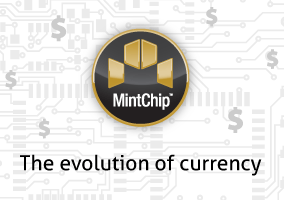Moving everyday transactions into the digital realm seems an inevitability, but as yet there have been no breakout successes. Sure, there are fringe efforts like Square (which relies on existing card and bank infrastructure) and Google Wallet (which is a bit early to the NFC party), but there’s nothing that the average consumer would see and think “yes, that is as simple as handing the merchant a five-dollar bill.”
The Royal Canadian Mint is hoping to create such a system: a multi-platform, simple, and secure alternative to cash. Others around the net have likened it to Bitcoin, but that’s really an inapt comparison. MintChip isn’t a virtual currency, it’s a virtual wallet, something which has been tried before. But, naturally enough, they hope to succeed where others have failed. But are they writing a check they can’t cash?
Briefly, it must be explained why MintChip is nothing like Bitcoin. Bitcoin is a fundamentally different style of currency: a regulated “resource” that uses a totally different method of exchange than cash. It’s very secure in a way, but the aspects that give it that security also make it foreign to existing and familiar payment methods, and by extention, users. Furthermore, its value fluctuates wildly, making it unsuitable for everyday purchases like coffee and cab fare.

MintChip, named after the Mint, the chip enabling the system, and perhaps inadvertently the ice cream flavor, is just a way of securely exchanging Canadian dollars (or at some point, they would hope, other currencies) by means of trusted hardware and straightforward accounting. The actual chip can be fitted into a number of devices, from micro SD cards to POS systems. MintChip value is transferred onto a chip by a MintChip broker, and can then be transferred independently between chips, online or off.
They claim the system is secure and anonymous, though any system that relies on trusted hardware and intermediaries is vulnerable to spoofing and duplication. And anonymity is not an easy promise either: as long as amounts and transfers are tied to account numbers, and account numbers are tied to identities and cards used to purchase funds, anonymity is far from assured. It’s not clear from the spec when and how long account and transaction information is stored. The litmus test is, realistically speaking, is it anonymous enough that someone could buy drugs with it without thinking twice?
The reliance on trusted, independent hardware seems like the weak link here, and all it will take is a few hackers (on their own or backed by bank and credit interests) to make public a tool that fools either brokers or merchants into thinking a transaction has taken place. Not a trivial task, but far from impossible. This gives the whole system a bad smell for anyone looking to adopt it. Credit card fraud is rampant, admittedly, but that’s more a function of the system’s widespread use and acceptance. MintChip doesn’t have the advantage of being accepted everywhere.
It’s an admirable effort and the Mint should be praised for the project, but this is likely to end up a dead end. But it’s a necessary dead end to explore, and the shortcomings of this system will inform the next version, and so on.
Lastly, since the most exciting part of a story must always come last, the Mint is holding a contest, giving away thousands of dollars in pure gold as prizes. Grand prize, for best overall application, gets one 10-ounce wafer of pure gold, with an enduring value of around $17,000. Judges include representatives from the Mint, Google, eBay, and the CBC. If you’re a developer interested in payments, and you love gold, check it out.
[via Hacker News]
